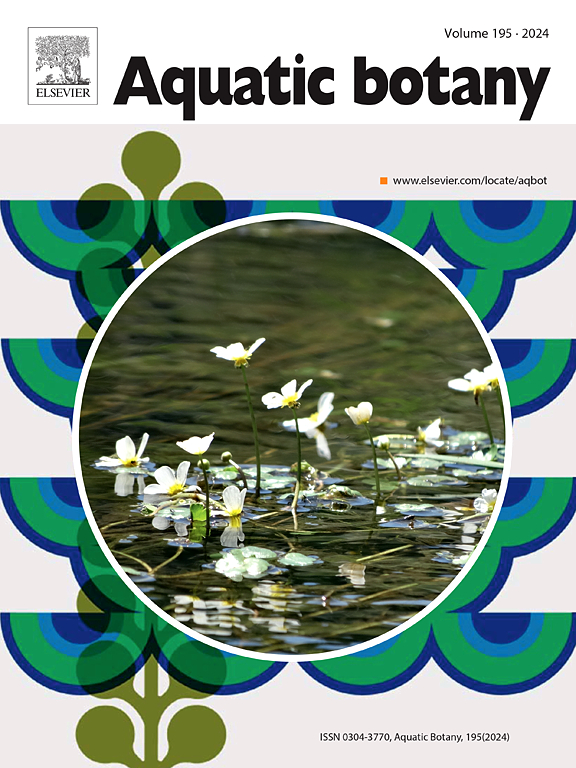Response of the submerged macrophyte Stuckenia pectinata (L.) Börner to warming in different climate regions: A synchronized oligohaline mesocosm experiment
IF 2.6
4区 生物学
Q2 MARINE & FRESHWATER BIOLOGY
引用次数: 0
Abstract
Submerged macrophytes play a crucial role as primary producers and contribute essential ecosystem functions and services, but rising temperatures caused by climate change may alter their functional traits. We aimed to assess the effects of simulated climate warming (4.5 °C) on the functional trait responses of a submerged macrophyte, Stuckenia pectinata (L.) Börner, in a synchronized oligohaline (4 ppt salinity) mesocosm experiment conducted in two different climate regions in Turkey: cold semi-arid Ankara and hot, dry Mediterranean Mersin. The experiment was conducted using eight mesocosms at each site, with four replicates of each ambient temperature and warming treatment. Each mesocosm held 5000 L and was inoculated with natural sediment, plankton, macroinvertebrate and fish communities to represent natural oligohaline lake ecosystem. S. pectinata shoots collected from a single population from a coastal lake in Mersin were also inoculated in all mesocosms in similar abundances. Overall, we observed significant differences in macrophyte functional traits between the two sites with different climates, albeit with less pronounced effects of a 4.5 ºC rise in temperature within each site. Specifically, higher macrophyte percent volume infested (PVI) and canopy height were observed in the warmer Mersin than in the colder Ankara, which we attributed to higher shading by phytoplankton (reflected by water column Chlorophyll a, Chl-a). The biomass ratio (%dry weight (DW)/wet weight (WW)) was notably higher in Ankara, suggesting that the macrophytes in Ankara acquired relatively more resources than those in Mersin. The pronounced differences between the two sites likely reflected not only temperature differences but also cascading ecosystem characteristics (e.g., water column Chl-a, water nutrients) due to climatic differences.
沉水植物果胶菌(Stuckenia pectinata, L.)的响应Börner对不同气候区域变暖的影响:一个同步的低盐中尺度实验
潜水植物作为初级生产者具有重要的生态系统功能和服务,但气候变化引起的温度升高可能改变其功能特征。本研究旨在评估模拟气候变暖(4.5°C)对沉水大型植物pectinata Stuckenia (L.)功能性状响应的影响。Börner,在土耳其两个不同气候区:寒冷半干旱的安卡拉和炎热干燥的地中海梅尔辛进行的同步低盐(4 ppt盐度)中尺度实验中。在每个试验点设置8个中生态系统,每种环境温度和加温处理设置4个重复。每个中生态含有5000 L,接种了天然沉积物、浮游生物、大型无脊椎动物和鱼类群落,代表天然低盐湖泊生态系统。从梅尔辛沿海湖泊的一个单一种群收集的果胶菊芽也接种在所有中生态系统中,丰度相似。总体而言,我们观察到不同气候条件下两个地点的大型植物功能性状存在显著差异,尽管每个地点温度升高4.5ºC的影响不太明显。具体而言,温暖的梅尔辛比寒冷的安卡拉观测到更高的大型植物侵染体积百分比(PVI)和冠层高度,我们将其归因于浮游植物的更高遮阳(通过水体叶绿素a, Chl-a反映)。安卡拉的生物量比(干重/湿重)显著高于梅尔辛,表明安卡拉的大型植物获得的资源相对较多。两个地点之间的显著差异可能不仅反映了温度差异,还反映了气候差异导致的级联生态系统特征(如水柱Chl-a,水营养物)。
本文章由计算机程序翻译,如有差异,请以英文原文为准。
求助全文
约1分钟内获得全文
求助全文
来源期刊

Aquatic Botany
生物-海洋与淡水生物学
CiteScore
3.80
自引率
5.60%
发文量
70
审稿时长
6 months
期刊介绍:
Aquatic Botany offers a platform for papers relevant to a broad international readership on fundamental and applied aspects of marine and freshwater macroscopic plants in a context of ecology or environmental biology. This includes molecular, biochemical and physiological aspects of macroscopic aquatic plants as well as the classification, structure, function, dynamics and ecological interactions in plant-dominated aquatic communities and ecosystems. It is an outlet for papers dealing with research on the consequences of disturbance and stressors (e.g. environmental fluctuations and climate change, pollution, grazing and pathogens), use and management of aquatic plants (plant production and decomposition, commercial harvest, plant control) and the conservation of aquatic plant communities (breeding, transplantation and restoration). Specialized publications on certain rare taxa or papers on aquatic macroscopic plants from under-represented regions in the world can also find their place, subject to editor evaluation. Studies on fungi or microalgae will remain outside the scope of Aquatic Botany.
 求助内容:
求助内容: 应助结果提醒方式:
应助结果提醒方式:


